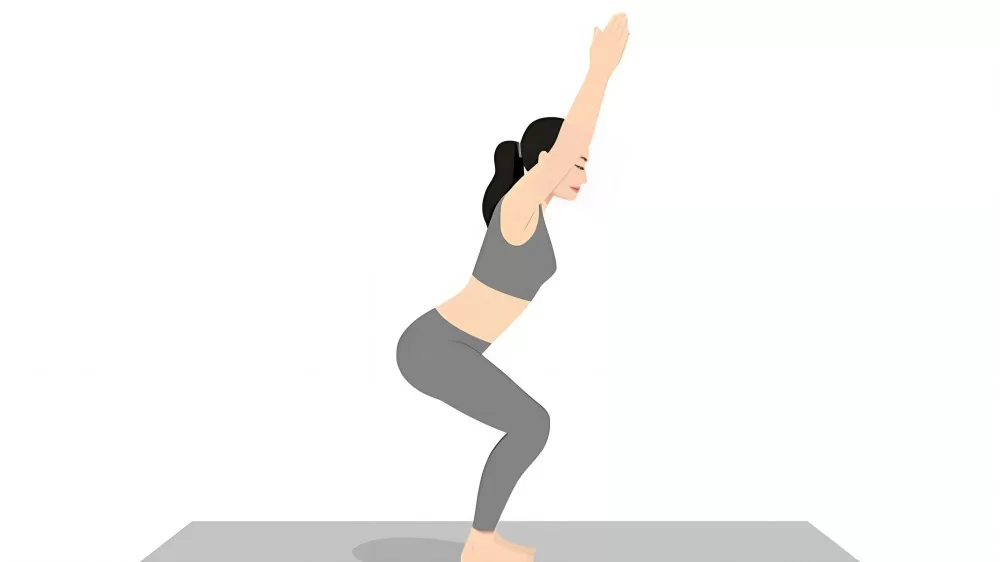
What is Utkatasana?
Utkatasana, derived from Sanskrit, translates to “powerful pose” or “fierce pose,” which gives you a good idea of what to expect. In English, it’s often called Chair Pose because it looks like you’re sitting in an invisible chair. This pose is excellent for building strength, especially in your lower body, while also improving balance and focus.
How to Do Utkatasana (Chair Pose)
Start in Tadasana (Mountain Pose)
Stand up straight with your feet together, grounding through all four corners of your feet.
Keep your arms relaxed by your sides, and take a few deep breaths to center yourself.
Raise Your Arms
Inhale deeply and stretch your arms up toward the ceiling.
Keep your arms parallel to each other, palms facing inward. If it feels comfortable, you can bring your palms together.
Ensure your shoulders are relaxed, and draw them away from your ears.
Bend Your Knees
As you exhale, bend your knees as if you’re sitting back into a chair.
Try to keep your thighs as parallel to the floor as possible. It’s okay if you can’t go that low—just bend as much as you can while maintaining balance.
Your knees should stay directly above your feet, not extending beyond your toes.
Engage Your Core
Keep your back straight and lengthen your spine.
Engage your core muscles by pulling your navel slightly inward toward your spine.
Tilt your pelvis slightly to avoid overarching your lower back.
Hold the Pose
Hold this position for 5-10 breaths, or as long as feels comfortable.
Focus on steady breathing and maintaining balance.
Return to Mountain Pose
To come out of the pose, straighten your legs on an inhale and bring your arms down as you exhale.
Return to Tadasana and take a moment to feel the effects of the pose.
Benefits of Utkatasana
Strengthens the Lower Body
Utkatasana is fantastic for building strength in your thighs, calves, and ankles. It also engages the glutes, which helps tone and firm the muscles in your lower body.
Improves Balance and Stability
Balancing in Utkatasana requires focus and coordination. Regular practice can enhance your balance, making you more stable in other yoga poses and daily activities.
Increases Core Strength
By engaging your core during the pose, you build abdominal strength and stability. A strong core supports your spine and improves overall posture.
Stretches the Chest and Shoulders
As you raise your arms in Utkatasana, your chest and shoulders get a gentle stretch. This can help relieve tension in the upper body and improve flexibility.
Boosts Mental Focus
Utkatasana is not just a physical challenge; it also requires mental focus. Concentrating on your breath and maintaining the pose can help improve your concentration and reduce stress.
Stimulates the Heart
Holding Utkatasana increases your heart rate, providing a gentle cardiovascular workout. It’s a great way to get your blood flowing and energize your body.
Supports Healthy Digestion
The gentle compression of the abdomen in Utkatasana can stimulate the digestive organs, promoting better digestion and helping to relieve constipation.
It’s here Garudasana How to Do It and what are the Benefits
FAQs
Q: Is Utkatasana suitable for beginners?
A: Yes, Utkatasana is accessible to beginners, though it can be challenging. Start with a shallow bend in the knees and work your way up as you build strength and flexibility.
Q: How long should I hold Utkatasana?
A: Hold the pose for 5-10 breaths to start. As you get stronger, you can increase the duration or repeat the pose multiple times during your practice.
Q: What should I do if I feel knee pain in Utkatasana?
A: If you experience knee pain, try not to bend your knees as deeply. Ensure your weight is in your heels and your knees are aligned with your toes. If pain persists, consult a yoga instructor for guidance.
Q: Can I practice Utkatasana if I have back problems?
A: If you have a history of back issues, approach Utkatasana with caution. Focus on keeping your spine long and avoid overarching your lower back. If you feel discomfort, it’s best to modify the pose or consult with a yoga instructor.

